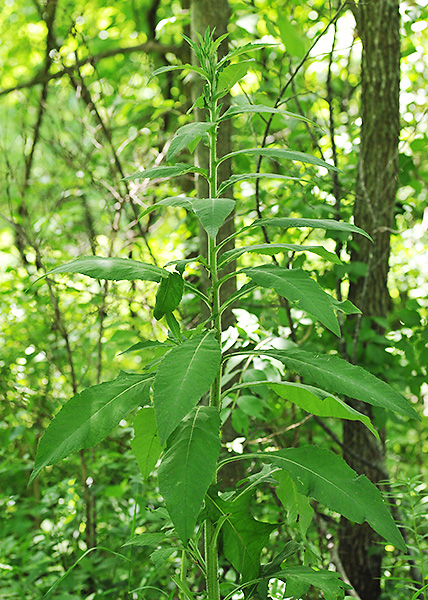
July 4, 2014. Amana (41°45'56" N 91°52'46" W)
| Classification Hierarchy | |
| Kingdom | Plantae |
| Subkingdom | Tracheophyta |
| Superdivision | Spermatophyta |
| Division | Magnoliophyta |
| Class | Magnoliopsida |
| Subclass | Asteridae |
| Order | Asterales |
| Family | Asteraceae |
| Genus | Cirsium |
| Species | Cirsium altissimum |
Scientific Name: Cirsium altissimum [syn? C. iowenses—see discussion].
Common Name: Tall thistle
Origin: Native
Notes: "Primary Noxious Weed". Biennial with taproot, reproduction by seed. A form of this plant but with more deeply divided leaves is sometimes called C. iowenses. It has also been suggested that C. iowenses is a hybrid between C. altissimum and C. discolor—which are very similar, except for the shape of their leaves (C. discolor has deeply divided leaves).
Additional references: 1, 2, 3, 4, 5, 6, 7, 8, 9, 10, 11, 12, 13.
Flowers: August; flowers perfect, purplish-pink, sometimes white; heads subtended by one or more spiny leafy bracts; involucres 2-3.5 cm high.
Stems: pilose, ridged, some as tall as nine feet.
Leaves: cauline leaves undivided or pinnatifid lobed, margins mostly entire with weak spines, basel leaves may be lobed; top surface green smooth or with short stiff hairs, underside of leaf with a tomentum of white hair.
Glossaries of botanical terms: 1, 2, 3, 4, 5, 6, 7, 8, 9, 10.
Comments: Tall thistle(Cirsium altissimum) is very similar to field thistle(Cirsium discolor). The observation that tall thistle is often found along the shaded edges or shady paths of deciduous woodlands, is consistant with my own experience. When found in sunny openings, the leaves of tall thistle seem to be more deeply divided and consequently seem more similar to the field thistles which have more deeply divided leaves and are usually found in prairies and other open sunny areas. Tall thistle is more shade tolerant than most thistles, it has softer spines, and the leaf margins may be entire, toothed, or lobed. All three variations may appear on the same plant. Usually the most divided leaves appear on the lower part of the plant. Field thistle has a more consistant leaf form. All of the leaves have deeply divided margins with a stiff spine on the tip of each lobe. Understanding the relationship between C. altissimum, C. discolor, and C. iowenses awaits further study.